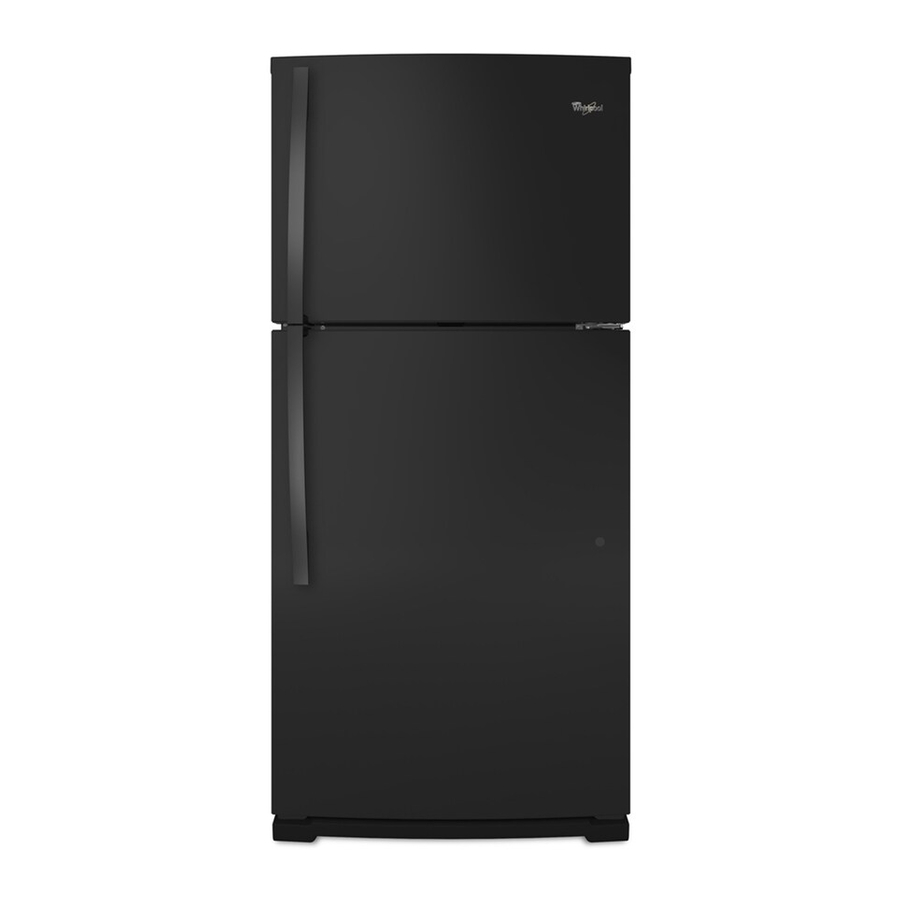Whirlpool WRT359SFYM Manuel de l'utilisateur - Page 16
Parcourez en ligne ou téléchargez le pdf Manuel de l'utilisateur pour {nom_de_la_catégorie} Whirlpool WRT359SFYM. Whirlpool WRT359SFYM 40 pages. Energy guide
Également pour Whirlpool WRT359SFYM : Manuel de l'énergie (1 pages)

First try the solutions suggested here or visit our website and reference FAQs (Frequently Asked Questions)
Refrigerator Operation
The refrigerator will not operate
WARNING
Electrical Shock Hazard
Plug into a grounded 3 prong outlet.
Do not remove ground prong.
Do not use an adapter.
Do not use an extension cord.
Failure to follow these instructions can result in death,
fire, or electrical shock.
Power cord unplugged? Plug into a grounded 3 prong outlet.
Is outlet working? Plug in a lamp to see if the outlet is
working.
Household fuse blown or circuit breaker tripped? Replace
the fuse or reset the circuit breaker. If the problem continues,
call an electrician.
Control(s) on? Make sure the refrigerator control is on. See
"Using the Control(s)."
New installation? Allow 24 hours following installation for the
refrigerator to cool completely.
NOTE: Adjusting the temperature control(s) to coldest setting
will not cool the refrigerator more quickly.
The motor seems to run too much
Your new refrigerator may run longer than your old one due to its
high-efficiency compressor and fans. The unit may run even
longer if the room is warm, a large food load is added, the door is
opened often, or if the door has been left open.
The refrigerator seems noisy
Refrigerator noise has been reduced over the years. Due to this
reduction, you may hear intermittent noises from your new
refrigerator that you did not notice from your old model. Below are
listed some normal sounds with explanations.
Buzzing - heard when the water valve opens to fill the ice
maker
Pulsating - fans/compressor adjusting to optimize
performance.
Hissing/Rattling - flow of refrigerant, movement of water
lines, or from items placed on top of the refrigerator.
Sizzling/Gurgling - water dripping on the heater during
defrost cycle
16
TROUBLESHOOTING
to possibly avoid the cost of a service call.
In the U.S.A., www.whirlpool.com
In Canada, www.whirlpool.ca
Popping - contraction/expansion of inside walls, especially
during initial cool-down.
Water running/dripping - may be heard when ice melts
during defrosting and water runs into the drain pan.
Creaking/Cracking - occurs as ice is being ejected from the
ice maker mold.
The doors will not close completely or they pop open
Door blocked open? Move food packages away from door.
Bin or shelf in the way? Push bin or shelf back in the correct
position.
Crisper cover in the way? Make sure the crisper cover is fully
pushed in, so that the back rests on the supports.
Refrigerator not tilted toward the rear? So the doors will
close easier, raise the front of the refrigerator so that it tilts
slightly downward toward the rear. See "Adjust the Doors."
Door closed too quickly? Close the door slowly and firmly to
keep the door from popping open.
The door is difficult to open
WARNING
Explosion Hazard
Use nonflammable cleaner.
Failure to do so can result in death, explosion, or fire.
Gaskets dirty or sticky? Clean gaskets and contact surfaces
with mild soap and warm water. Rinse and dry with soft cloth.
Temperature and Moisture
Temperature is too warm
New installation? Allow 24 hours following installation for the
refrigerator to cool completely.
Door opened often or left open? Allows warm air to enter
refrigerator. Minimize door openings and keep door fully
closed.
Large load of food added? Allow several hours for
refrigerator to return to normal temperature.
Control(s) set correctly for the surrounding conditions?
Adjust the control(s) a setting colder. Check temperature in
24 hours. See "Using the Control(s)."
